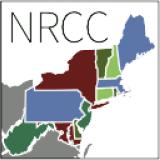For the latest forecasts and critical weather information, visit weather.gov.
Coastal parts of northern New England saw relief from Elsa—but not interior locations or Cape Cod
For more details, see the Northeast Drought Early Warning System Dashboard.
Key Points
- Severe Drought (D2) persisted in parts of Maine and New Hampshire.
- Moderate Drought (D1) held on in northern New York, Vermont, New Hampshire, much of western Maine, and Cape Cod.
- Abnormally Dry (D0) conditions—strongly indicated by a lack of groundwater recharge—will be watched closely in all of northern New England, parts of New York, and Cape Cod.
Current U.S. Drought Monitor map for the Northeast Drought Early Warning System with data valid for July 13, 2021. The U.S. Drought Monitor is updated each Thursday to show the location and intensity of drought across the country.
According to the latest U.S. Drought Monitor:
- Severe drought (D2) exists in 2.6% of the region.
- Moderate drought (D1) conditions exist in 20.3% of the region.
- Abnormally dry (D0) conditions exist in 29.1% of the region.
U.S. Drought Monitor Categories
Current U.S. Drought Monitor map for the Northeast Drought Early Warning System with data valid for July 13, 2021. The U.S. Drought Monitor is updated each Thursday to show the location and intensity of drought across the country.
According to the latest U.S. Drought Monitor:
- Severe drought (D2) exists in 2.6% of the region.
- Moderate drought (D1) conditions exist in 20.3% of the region.
- Abnormally dry (D0) conditions exist in 29.1% of the region.
Current Conditions
7-Day Average Streamflows
Streamflows are high or much above average across much of New York, Connecticut, Massachusetts, and Rhode Island and southern parts of New Hampshire and Vermont. Parts of northern New Hampshire and Vermont, and parts of Maine, are seeing below-normal or much-below-normal streamflows.

Annual Precipitation Departure from Normal

State-Reported Impacts
Maine
- Rainfall from Elsa brought increases in streamflow, but only for stations within 50–75 miles of the Maine coast.
- Persistent showers have reduced the need for supplemental irrigation of crops in many areas.
- Dry Well Survey
- Ants in Maine
- Elsa soaks Maine but more rain is needed
Massachusetts
New Hampshire
- Recent rains provided 3–6 inches in much of the southern half of the state, but much less in the north, where the rain was most needed. As a result, drought and abnormally dry conditions have receded north.
- At the end of June, groundwater level monitoring indicated that most wells in the network were below average and had dropped since the end of May. Due to the growing season and warm summer temperatures, most rain received goes to plants and evaporation or runoff. Significant groundwater recharge will not occur until the fall.
- Streamflows have recovered in the majority of the state, except for the north.
- The New Hampshire Department of Environmental Services is urging systems to maintain outdoor water use restrictions. Implementing mandatory restrictions is prudent in areas experiencing moderate drought, particularly in areas which experience a significant increase in outdoor water use in the summer. Those areas experiencing abnormally dry conditions should be messaging water conservation to residents and customers, as well as be implementing restrictions based on availability of supplies and increases in demand.
- Currently 86 water systems have restrictions in place.
- Elsa soaks New Hampshire, but like Maine, more rain is needed.
Sign Up for U.S. Drought Monitor Alerts
Outlooks
- The 8–14 day outlook indicates normal temperatures for the region except for western New York, where above-normal temperatures are favored. Below-normal precipitation is favored for Connecticut, Massachusetts, and Rhode Island, southern New Hampshire and Vermont, and central and southern New York. Normal precipitation is favored for the rest of the region.
- The 3–4 week outlook favors above-normal temperatures across almost all of the Northeast and equal precipitation chances for the region, except for western New York, where above-normal precipitation is favored.
Temperature Outlook 8–14 Day

Precipitation Outlook 8–14 Day

Temperature Outlook Week 3–4

Precipitation Outlook Week 3–4

Additional Resources
- Northeast DEWS Dashboard
- NOAA Regional Climate Services
- Your local National Weather Service office
- NOAA Regional Climate Services Monthly Webinar Series (next webinar is on July 29)
- USDA Northeast Climate Hub
- USGS New England and New York Water Science Centers
Contacts for More Information
Sylvia Reeves
Regional Drought Information Coordinator (Northeast DEWS)
NOAA/CIRES/National Integrated Drought Information System (NIDIS)
Email: sylvia.reeves@noaa.gov
Ellen L. Mecray
Regional Climate Services Director, Eastern Region
NOAA/NESDIS/National Centers for Environmental Information
Email: Ellen.L.Mecray@noaa.gov
Prepared By
Sylvia Reeves
NOAA/National Integrated Drought Information System (NIDIS)
Samantha Borisoff, Jessica Spaccio, Keith Eggleston, Art DeGaetano
Northeast Regional Climate Center
Ellen Mecray
Regional Climate Services Director, Eastern Region, NOAA
David Hollinger and Maria Janowiak
USDA Climate Hubs
Gardner Bent
USGS/New England Water Science Center
In partnership with National Weather Service Offices of the Northeast and State Climate Offices of the Northeast.
This drought early warning update is issued in partnership between the National Oceanic and Atmospheric Administration (NOAA), U.S. Geological Survey, and the U.S. Department of Agriculture (USDA) to communicate concern for drought expansion and intensification within the Northeast U.S. based on recent conditions and the forecasts and outlooks. NIDIS and its partners will issue future Drought Early Warning Updates as conditions evolve.






